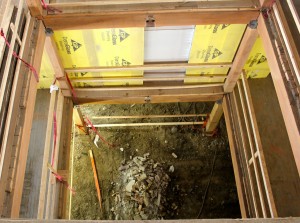I asked Ray Santangelo and David Kadish if stormwater drainage was a factor in the design of building 574. “It was actually required,” Kadish said. “The age of the building resulted in a system that sent the storm water to the sewer lines, which is no longer allowed by the city’s code. This resulted in the installation of filtration tanks to mitigate the amount of water being sent to the city’s infrastructure.” Stormwater infiltration systems are used to collect, treat, and recharge stormwater runoff generated from impervious areas of developments, such as roofs, sidewalks, and parking lots. They improve stormwater runoff quality and quantity and help to recharge underground aquifer water supplies, reduce the total volume and peak rate of runoff discharged from a site, and reduce the amount of water directed to City stormwater collection systems.
The conversation also included stormwater recharge systems. Kadish explained these in great detail. “For the 574 Boston Avenue project, there are a few different types of stormwater recharge systems, including pervious pavers, a drywell, and two pipe and stone systems. Pervious pavers allow runoff to infiltrate by providing enough space between each individual paver for water to pass into the underlying soils. A drywell is a concrete chamber with small holes in the concrete walls that drain the chamber. Pipe and stone systems are a mix of perforated pipe surrounded by crushed stone.” Crushed stone is a useful material for infiltration systems because of its high void properties. The more void space a soil has, the more stormwater it can ultimately store and infiltrate. All three types of systems use the same process, which is to collect runoff from impervious surfaces, store it within the system, and slowly let the runoff infiltrate into the underlying soil.
One of the challenges of the 574 Boston Avenue project was to reduce the total amount of runoff offsite. “The Harvard Avenue stormwater system was already overloaded and floods during large storm events,” the men explain. “The City required that we reduce the amount of runoff sent to the Harvard Street stormwater system by implementing infiltration systems to reduce runoff from the 574 site. The infiltration system on the Harvard Avenue side of the project was designed to store a 10-year storm, or 4.6-inches of rain in a 24-hour period.”
 This also has ramifications for the building’s LEED rating system, the environmental rating that assesses the green design of a project. Stormwater Quantity ratings require that a site infiltrate at least 25% of the runoff generated by a site. Using the techniques described above, the 574 Boston Avenue project will reduce the runoff sent to the City stormwater systems by almost 60%, a true representation of the design team’s dedication to sustainability.
This also has ramifications for the building’s LEED rating system, the environmental rating that assesses the green design of a project. Stormwater Quantity ratings require that a site infiltrate at least 25% of the runoff generated by a site. Using the techniques described above, the 574 Boston Avenue project will reduce the runoff sent to the City stormwater systems by almost 60%, a true representation of the design team’s dedication to sustainability.

Hi there everyone, it’s my first visit at this web site,
and post is actually fruitful in favor of me, keep up posting these types of articles.